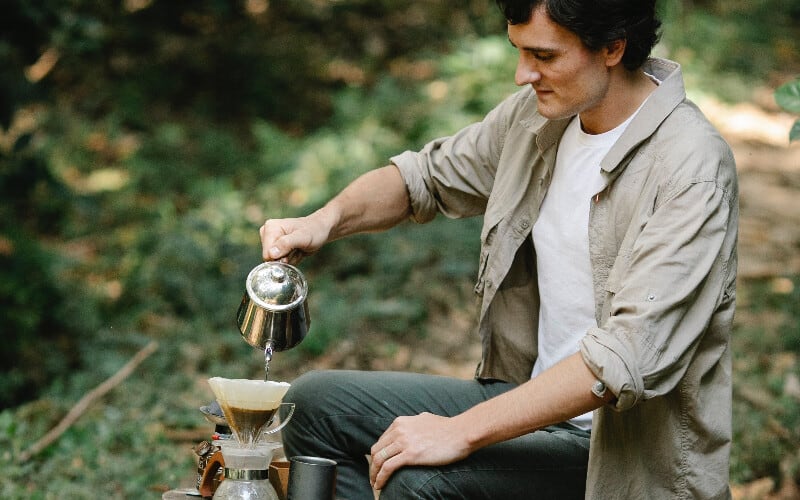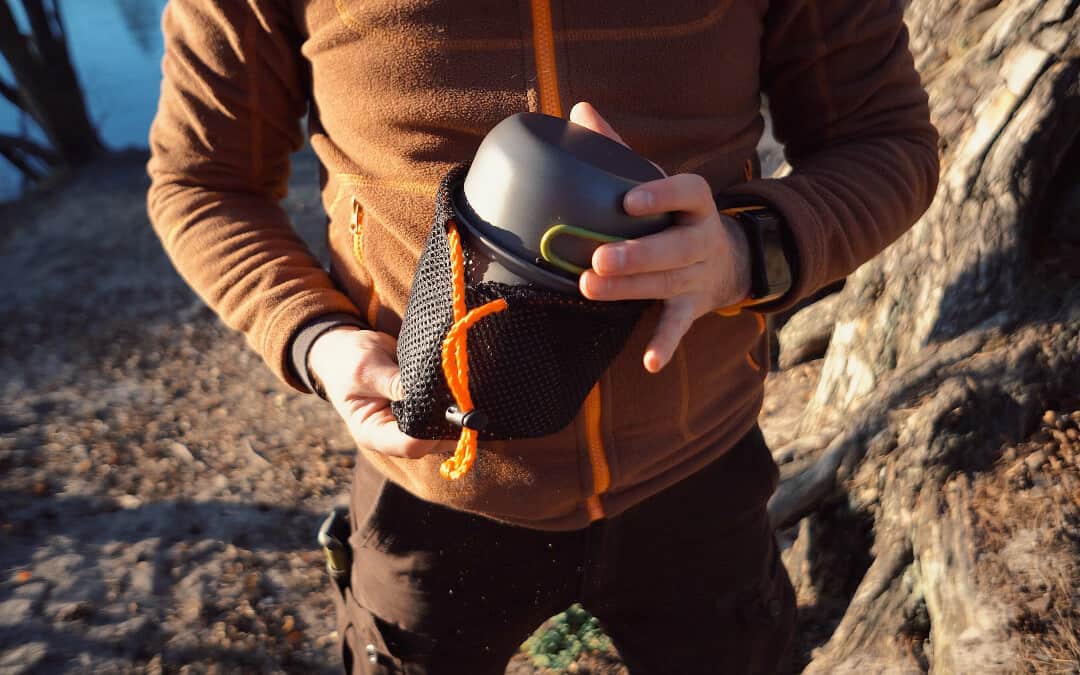Contents
The Best Camping Water Containers of 2021
Water is the essence of life, and without it you’re going to have a bad time-camping or not. When talking about water, the Rule of 3 applies – specifically you can only survive for about 3 days without it.
This is where camping water containers come into play. You can never stock up and have too much drinking water on hand. If you run low, there are ways to sanitize water if you happen to be near a water source (investing in a water filter is always a good idea), but it’s a wise idea to be prepared by bringing clean, potable H20 with you for yourself and your camping partners (friends/family/etc.). Try to avoid bringing bottled water if possible – they provide safe water but create an incredible amount of waste that could easily be avoided… plus, they take up a lot of space!
We’ve tried just about all of the water container & storage options on the market, from giant coolers to a collapsible bucket, and have narrowed it down to the best camping water containers for just about anyone’s needs. Whether you need something that can hold enough for a family weekend, or just want something rugged to last you on your solo outing, or anything in between, you’ll find it reviewed below.

It may seem trivial, but not all containers are created equal – some are poorly designed, leak, or are difficult to move around. So we’ve sifted through these and bring you only the highest quality, most reliable options, based on the following criteria:
Water Container Criteria
Size & Capacity
Space is pretty much always a factor when it comes to making purchase decisions, and that’s especially true when it comes to looking for a portable water storage container for your next camping trip. If it’s just going to be you out for a weekend, you likely won’t need 8+ gallons, so a small to mid-size container should suffice (which leaves room for other gear in your car/truck & at your campsite).
It’s also important to consider that the bigger the container, the more it holds. The more it holds, the heavier it gets. The heaver it gets, the more difficult and cumbersome it becomes to move. If you need a lot of water, it’s not a bad idea to consider picking up a few smaller-sized containers to fill, instead of one giant container. In this case, stackable and collapsible options are a great choice, as they fit together neatly and take up very little space once empty.
If you decide you need one or more large containers, bringing along a few smaller ones can come in handy so you can take some water from the larger container(s) and put it into the smaller container(s) which will allow you to stay mobile.
Quality & Durability
Plastic is the most common material that these containers are made from, and with good reason. You can find storage containers made of glass or even metal, but they both have downsides compared to plastic. Glass can crack and break (obviously) so it’s not a good choice, especially if you’re going to be moving the container around on your outings. Metal can rust if not treated properly, and rusty, metallic tasting drinks are far from ideal.
With that said, not all plastic containers are equal. Many containers are made of cheap, flimsy plastic that can crack or leak, so you want to look for more durable options that can withstand a bit of a beating.
Additionally, you want to ensure you don’t choose just any plastic-you need plastic that is rated safe for food use. Otherwise, these plastics may contaminate your drinking water, which is bad news. Don’t reuse old milk jugs or similar as bacteria can thrive in the porous surfaces no matter how thoroughly you clean them, which means they can replicate.
Camping Water Container Reviews
Reliance Products Aqua-Tainer 7 Gallon Rigid Container
With 7 gallons of capacity, Reliance Products Aqua-Tainer is the largest water container on our list, making it a good choice if you’re spending multiple days camping or have multiple people with on your trip.
Due to its size, this water container gains considerable weight when filled up, but it has a handle on the top to make it easier to carry. Needless to say, this water jug will occupy a lot of area in your tent, so it may be more appropriate to keep in your vehicle if it will be nearby.
The Aqua-Tainer 7-gallon water container is made from rigid BPA-free plastic, so it’s fairly durable and, most importantly, safe. However, if you want to be able to store your containers stacked, then this probably won’t be the best choice. You would need to put the containers sideways to stack them, but it’s not a great idea since the plastic isn’t durable enough for that. In fact, this container doesn’t take abuse very well.
For easier dispensing, there is a spigot installed in the cap. To use it, you would have to unscrew it and put it on the top of the cap.
Pros:
- Large capacity.
- Fairly rigid.
Cons:
- Heavy when filled.
Coghlan’s Collapsible 5-Gallon Water Container
Coghlan’s collapsible water container has a solid capacity: it’s a 5 gallon container, to be exact. This choice probably won’t be much more compact than the 7-gallon Aqua-Tainer. At least, when it is full. The most remarkable feature of this is that it can be folded down when empty, making it a great choice for camping trips since it can be easily stored without taking too up much space when empty.
Coghlan’s collapsible container also comes with a spigot cap. To use it, you would need to put the container on the side so the spigot faces the ground. And by the way, the spout of the canister is big enough to take ice cubes.
The collapsible design of this water container causes an issue, though: it appears not to hold its shape well when not full, so you would need to be a bit careful.
Pros:
- Collapsible.
- Good capacity
Cons:
- Doesn’t hold its shape when partially full.
Coleman 5-Gallon Carrier
The Coleman 5-gallon carrier is another good choice for camping thanks to its portability. It appears to have a more rigid construction than Coghlan’s the collapsible version (outlined above). However, designed to be foldable, this water carrier is nearly as easy to store.
This water container also comes with a spigot. To use it, you need to put the water container sideways. However, you don’t need to put the it back upright for transport since it has a carrying handle on its side (which becomes the top when the container is sideways).
The spigot of this camping water jug tends to drip slowly. For cups, the flow should be more than enough, but it probably won’t be sufficient for quick filling of large bottles.
Pros:
- Has two carrying handles.
- Folds flat.
Cons:
- Slow flow from the spigot.
Igloo 5-Gallon Heavy-Duty Beverage Cooler
Igloo 5 gallon heavy-duty beverage cooler is possibly the most noteworthy portable water container in this list.
First of all, it’s a fair bit better at keeping beverages cool (or hot! see below under “Other Reasons These Containers are Useful – Parties” for more), because it is insulated better than many other options.
Secondly, it has an easier to use spigot: you just need to push a button on instead of rotating a valve. The spigot is slightly angled forward, so you won’t need to keep the cup directly under it (which isn’t always convenient) for filling.
The Igloo 5-gallon cooler should also be easy to transport since it comes with two side handles. As it holds 5 gallons, and it has a lot of insulation, it’s probably not the best choice if you’re worried about space.
Igloo also offers an optional drip catcher tray or 50 cups with their 5-gallon beverage cooler.
The main downside of this option is its lid. It’s not a screw lid, it’s just pushed down onto the container. This means its contents can easily spill if it’s bumped or knocked over.
Pros:
- Optional drip catcher tray.
- Keeps beverages cool.
Cons:
- The lid isn’t held in place by anything.
Reliance Products Desert Patrol 3-Gallon Rigid Water Container
The Reliance Products Desert Patrol 3-gallon water container is made in the traditional “Jeep” style. It makes our list of the best camping water containers because it’s designed to be easy to carry: it features a wide handle that can be used for two-hand carrying.
When it comes to materials, this camping water container is pretty sturdy, so it can take a beating pretty well. However, it can’t be stored stacked nonetheless. To do that, you would need to put it sideways. And when sideways, the valve in the cap appears to leak.
This water container also doesn’t come with a spigot, so you would need to get one.
Pros:
- Easy to carry.
- Sturdy.
Cons:
- The vent tends to leak.
- Doesn’t come with a spigot.
Brio 2-Gallon Plastic Jug Container
If you’re looking for both sturdy and compact camping water container, then Brio 2-gallon plastic jug could be the right choice for you. It is made from heavy-duty, BPA- & BPS-free Tritan Resin that is engineered to be both safe and durable. And because it’s not very large, it could be a better choice for those concerned about storage space.
When it comes to downsides, Brio water container doesn’t come with a spigot. Instead, you would need to get Brio’s water dispenser. Secondly, it comes with difficult to remove stickers. And lastly, because this container’s handle is on the side rather than on the top, some may find it more difficult to carry.
Pros:
- Durable.
- Compact.
Cons:
- Comes with difficult to remove stickers.
- No spigot.
- Could be difficult to carry.
API Kirk Samson Stacker Water Storage Containers
For storage and transportation, API Kirk Samson Stacker water storage containers will probably be the right choice. It’s easily stackable, so it’s a great choice if you want to bring along more than one water jug. And secondly, it comes with a well-sealed cap.
The API Kirk doesn’t include a spigot, though. It can be a bit difficult to unscrew the cap once it has been tightly screwed in. Because of this, it seems that this water container would be a more suitable choice for spare water storage in your car that you can revisit to fill up your insulated water bottle throughout the day.
Pros:
- Stackable.
- Good for large amounts of H20.
Cons:
- No spigot included.
- The cap screws too tightly.
Maintenance & Care for Your Water Storage Containers
Fill your containers with warm water almost to the top, but leave an inch or two of air inside (if it’s a larger container, feel free to leave more air so it’s easy enough to pick up). Add a squirt or two of dish soap, preferably Dawn or similar, then seal it. Shake thoroughly. Allow it to sit for a few minutes, then pick it up and shake it again.
Pour out all of the liquid and rinse it out a few times to get rid of any soap residue. Refill the container with 4-5 cups of water, and add a teaspoon of bleach and seal it. Shake the container thoroughly yet again, then allow the container to sit for a few minutes.
Dump the chlorine mixture and thoroughly rinse the inside a few more times to get any remaining residue out.
At this point, your container is properly cleaned and you can allow it to air dry, or refill it with fresh, clean water and store it.
Water Storage Facts & Myths
Myth About Rotating Water
Myth: Water never needs to be rotated.
Fact: Properly stored water may not need to be rotated ever, but it’s a good idea to test it every 6 months to be sure. Even if it has been properlty treated, you can never be 100% sure nothing has contaminated the supply, so it’s better to be safe than sorry.
Myth About Treating Water
Myth: Water must be treated with chlorine and/or boiled before storing.
Fact: Unless you’re collecting from a well, a rain barrel, or a nearby water source (lake, river, etc.), your water has likely already been treated, so it’s not necessary to treat it again. With that said, it’s not a bad idea to test before you commit to storing it just to ensure no bacteria are present.
Myth About Storing Water in Plastic
Myth: If it Tastes Like Plastic, it’s Contaminated
Fact: As long as you’ve stored your water in a food-grade container, it should be perfectly potable, even if it has a slightly plastic-y taste. If you pour the it in a glass and let it breathe for a bit it can help reduce the plastic taste. Look for plastic containers that have the number 2, 4, or 5 on the inside of the recycle symbol on the container to ensure it’s safe for storage. Avoid any other symbol as it can have adverse effects on your health over time.
Myth About Storing Water in Your Garage
Myth: Your Garage is a Great Place to Store Drinking Liquids
Fact: Plastic is semi-permeable, which means it can absorb things around it. If you store your containers in your garage, there’s a chance it can collect from gas, car exhaust, and other chemicals or pollutants. It’s better to store your in an attic, basement, or storage room/closet whenever possible.
Other Reasons These Containers are Useful
Disaster Preparedness
You never know when disaster may strike. Severe storms and floods can cause contamination to your local supply, so it never hurts to have a backup supply… just in case. It could take up to a week (or more!) for first responders to render aid in a disaster, and that’s a *very* long time to go without potable water.
Sports Games
If you play sports or have a child that plays sports, bringing along a storage container is a great idea to help keep yourself, your teammates, your child(ren), their teammates, etc. hydrated. A water bottle is good, but more storage means better hydration for more people.
Road Trips
If you’re planning a long drive, having a fully-stocked water supply can help keep you hydrated on long stretches of road where there are few stops-plus it can save you a few bucks vs. buying bottles at gas stations!
Parties
You can use your containers a variety of liquids. Punch, hot cocoa, and more potent potables can be held in these containers. Some are better than others at keeping drinks warm (such as the Igloo 5-Gallon Heavy-Duty Beverage Cooler, listed above), so you’ll want to factor that in if you plan on serving up hot beverages. Note: it’s very important to clean out your containers as quickly as possible after use to prevent sticky buildup.
Conclusion
The containers we’ve reviewed above should cover just about everyone’s needs. If you know of a great option we’ve missed, let us know in the comments below and we’ll take a look and add it to the reviews.
If you’re in need of bottles for your trip, you have plenty of options: whether you prefer a reusable plastic bottle, a glass bottle, a stainless steel bottle, an insulated bottle, or a collapsible bottle, there’s something out there for everyone. Be sure to check out our reviews of the best camping water bottles.
In the end, choosing the best camping water containers is all about what’s right for you and your needs. Keep the tips above in mind as you look for the perfect container(s) and you can’t go wrong.


0 Comments